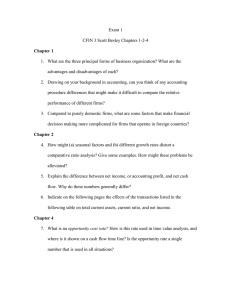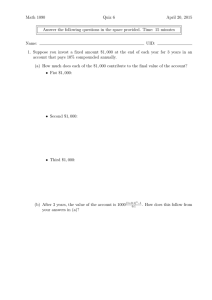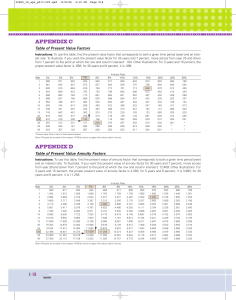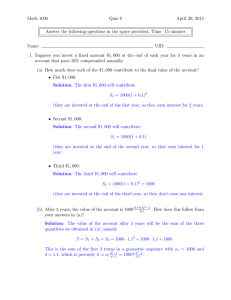Time Value of Money 15.511 Corporate Accounting July 2, 2004 Summer 2004
advertisement
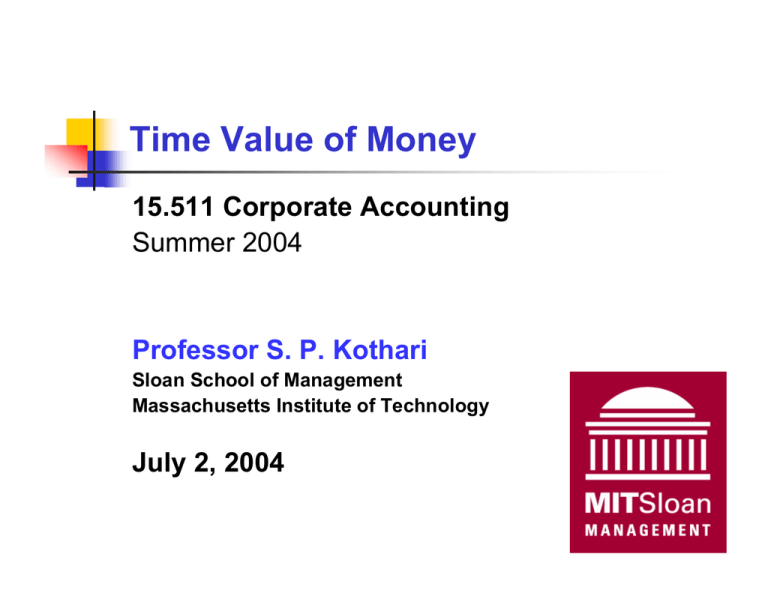
Time Value of Money
15.511 Corporate Accounting
Summer 2004
Professor S. P. Kothari
Sloan School of Management
Massachusetts Institute of Technology
July 2, 2004
1
LIABILITIES: Current
Liabilities
Obligations that must be discharged in a short
period of time (generally less than one year)
Reported on balance sheet at nominal value
Examples:
Accounts payable
Short-term borrowings
Current portion of long-term debt
Deposits
Warranties
Deferred Revenues / Income
2
LIABILITIES: Long-term
Liabilities
Obligations spanning a longer period of time (generally
more than one year)
Generally reported on the balance sheet at present value
based on interest rate when initiated
Examples:
Bonds
Long-term loans
Mortgages
Capital Leases
How do we compute present values? And interest
expense?
3
Time Value Of Money
Interest = 10%
Time 0
$1.00
Time 1
$1.00
Time 1
$1.10
Future value of $ 1.00 today = $1.00 (1+10%) = $1.10 at the end of one year.
What is the present value of $1.10 to be received one year from now?
Present value of $1.10 one year from now = $1.10/(1+10%) = $1.00
What is the present value of $1.00 to be received one year from now?
Present value of $1.00 one year from now = $1.00/(1.10) = $0.91
4
Time Value Of Money
$0.83
T=0
$1.00
$0.91
T=1
$1.10
$1.00
T=2
$1.21
Future value of $1.00 two years from now = $1.00*(1+10%)*(1+10%)
= $1.00*(1.10)2 = $1.21
Present value of $1.00 to be received two years from now
= $1.00/[(1.10)2] = $0.83
RECALL: PV of $1.00 to be received a year from now = $0.91
5
Calculating present values: An example
You have just won a lottery. The lottery board offers
you three different options for collecting your
winnings:
(1) Payments of $500,000 at the end of each year for
20 years.
(2) Lump-sum payment of $4,500,000 today.
(3) Lump-sum payment of $1 million today, followed
by $2,100,000 at the end of years 5, 6, and 7.
Assume all earnings can be invested at a 10 percent annual rate.
Ignoring any tax effects, which option should you choose and
why?
6
Future Value of Option 1: $500,000 at the
end of each year for 20 years.
0 1 2 3 4 5 6 7
19 years
18 years
17 years
19 20
$0.5m×(1.1)19= $3.06m
$0.5m×(1.1)18= $2.78m
$0.5m×(1.1)17= $2.53m
$0.5m×(1.1)1 = $0.55m
$0.5m×(1.1)0 = $0.50m
$28.64m
7
Future Value of Option 2: Lump-sum
payment of $4,500,000 today
0 1 2 3 4 5 6 7
20 years
19 20
$4.5m ×(1.1)20= $30.27m
8
Future Value of Option 3: $1m today, and
$2.1m at the end of years 5, 6, and 7.
0 1 2 3 4 5 6 7
19 20
20 years
$1.0m×(1.1)20= $3.36m
15 years
14 years
13 years
$2.1m×(1.1)15= $8.77m
$2.1m×(1.1)14= $7.97m
$2.1m×(1.1)13= $7.25m
$30.71m
9
Future Values
z
If you invest all lottery receipts at 10% per year,
how much will you have in 20 years?
1.
$500K × (1.10)19 + $500K × (1.10)18 + ...
... + $500K × (1.10)1 + $500K = $28.64m
2.
$4,500,000 × (1.10)20 = $30.27m
3.
$1m × (1.10)20 + $2.1m × (1.10)15 +
$2.1m × (1.10)14 + $2.1m × (1.10)13 = $30.71m
Î FV(Option 1) < FV(Option 2) < FV(Option 3)
10
Present Value of Option 1: $500,000 at
the end of each year for 20 years.
0 1 2 3 4 5 6 7
$0.5m×(1.1)-1 = $0.45m
1 year
$0.5m×(1.1)-2 = $0.41m
2 years
$0.5m×(1.1)-3 = $0.38m
3 years
$0.5m×(1.1)-19= $0.08m
$0.5m×(1.1)-20= $0.07m
19 20
19 years
20 years
$4.26m
11
Present Value of Option 2:
Lump-sum payment of $4,500,000 today
0 1 2 3 4 5 6 7
19 20
$4.5m
12
Present Value of Option 3: $1m today, and
$2.1m at the end of years 5, 6, and 7.
0 1 2 3 4 5 6 7
19 20
$1.0m×(1.1)0 = $1.00m
$2.1m×(1.1)-5 = $1.30m
$2.1m×(1.1)-6 = $1.19m
$2.1m×(1.1)-7 = $1.08m
5 years
6 years
7 years
$4.57m
13
Present Values
z
If all lottery receipts can be invested at 10% per
year, what is the present value of each option?
1.
$500K × (1.10)-20 + $500K × (1.10)-19 + …
... + $500K× (1.10)-2 + $500K × (1.10)-1 = $4.26m
2.
$4,500,000 × (1.10)0 = $4.5m
3.
$1m × (1.10)0 + $2.1m × (1.10)-5 +
$2.1m × (1.10)-6 + $2.1m × (1.10)-7 = $4.57m
Î PV(Option 1) < PV(Option 2) < PV(Option 3)
14
Converting Present and Future Values
Present
Values
Option 1
$4.26m
0 1 2 3 4 5 6 7
FV = 4.26 × 1.120 = 28.64
19 20
Future
Values
Option 1
$28.64m
PV = 28.64×1.1-20 = 4.26
Option 2
$4.50m
FV = 4.50 × 1.120 = 30.27
Option 2
$30.27m
PV = 30.27×1.1-20 = 4.50
Option 3
$4.57m
FV = 4.57 × 1.120 = 30.71
Option 3
$30.71m
PV = 30.71×1.1-20 = 4.57
15
Using PV and FV Tables (Appendix)
z
Table 1: Future Value of $1
z
z
z
z
A one-time payment to be received now and held (reinvested)
for N periods
Compounded at interest rate r%
Multiply the dollar amount received by the factor in Row N,
Column r%
Table 2: Present Value of $1
z
z
z
A one-time payment to be received N periods from now
Discounted at interest rate r
Multiply the dollar amount to be received by the factor in Row
N, Column r
16
Time Value of Money Terminology
z
Annuity: a stream of fixed-dollar payments made at
regular intervals of time
z
z
z
Ordinary Annuity (annuity in arrears): payments occur at the
end of the period
Annuity due (annuity in advance): payments occur at the
beginning of the period
Formulas:
z
FV(a) = { [((1+r)^N) - 1] / r} * Fixed Period Cash Flow
z
PV(a) = { [(1 - (1+r)^(-N))] / r] } * Fixed Period Cash Flow
17
Using PV and FV Tables (Appendix)
z
Table 3: Future Value of $1 ordinary
annuity (annuity in arrears)
z
z
z
z
Regular payments to be received at end of year for N years
and held (reinvested) until time N
Compounded at interest rate r%
Multiply the dollar amount received by the factor in Row N,
Column r%
FV of $1 annuity due (annuity in advance) = (FV of an
ordinary annuity for N+1 years) - $1
18
Using PV and FV Tables (Appendix)
z
Table 4: Present Value of $1 ordinary annuity
(annuity in arrears)
z
z
z
z
Regular payments to be received at end of year for N years
Discounted at interest rate r%
Multiply the dollar amount to be received by the factor in Row
N, Column r
PV of $1 annuity due (annuity in advance) = (PV of an
ordinary annuity for N-1 years) + $1
19


